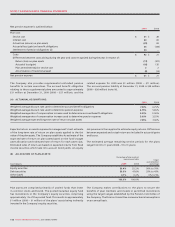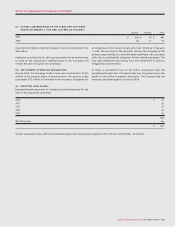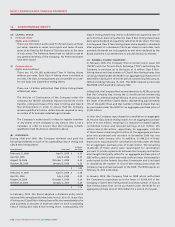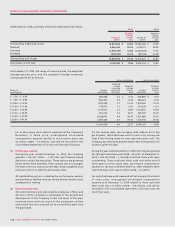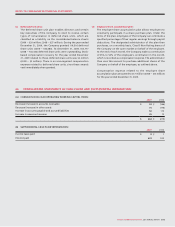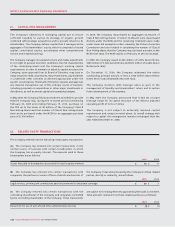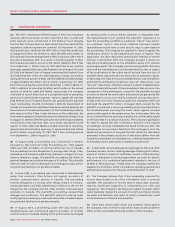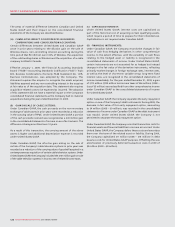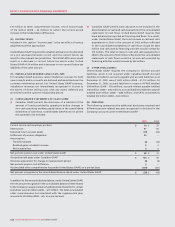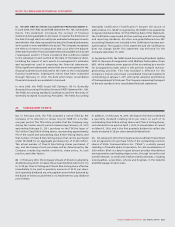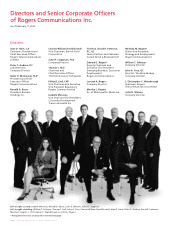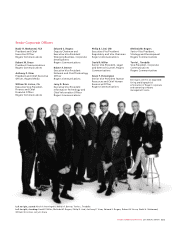Rogers 2009 Annual Report Download - page 120
Download and view the complete annual report
Please find page 120 of the 2009 Rogers annual report below. You can navigate through the pages in the report by either clicking on the pages listed below, or by using the keyword search tool below to find specific information within the annual report.
124 ROGERS COMMUNICATIONS INC. 2009 ANNUAL REPORT
NOTES TO CONSOLIDATED FINANCIAL STATEMENTS
The areas of material difference between Canadian and United
States GAAP and their impact on the consolidated financial
statements of the Company are described below:
(A) CUMULATIVE IMPACT OF DIFFERENCES IN BUSINESS
COMBINATIONS AND CONSOLIDATION ACCOUNTING:
Certain differences between United States and Canadian GAAP
arose in prior years relating to the dilution gain on the sale of
Wireless shares, non-controlling interest accounting during the
time period that RCI did not own 100% of Wireless, the acquisition
of the outstanding shares in Wireless and the acquisition of a cable
company in Atlantic Canada.
Effective January 1, 2009, the Financial Accounting Standards
Board (“FASB”) Accounting Standards Codification (“ASC”) Topic
805, Business Combinations (formerly FASB Statement No. 141R,
Business Combinations), was adopted by the Company. This
statement requires the acquirer to recognize the assets acquired,
liabilities assumed and any non-controlling interest in the acquiree
at fair value as of the acquisition date. This statement also requires
acquisition-related costs to be expensed as incurred. The adoption
of this statement did not have a material impact on the Company’s
consolidated financial statements as the Company had no material
acquisitions during the year ended December 31, 2009.
(B) GAIN ON SALE OF CABLE SYSTEMS:
Under Canadian GAAP, the cash proceeds on the non-monetary
exchange of cable assets in prior years were recorded as a reduction
in the carrying value of PP&E. Under United States GAAP, a portion
of the cash proceeds received was recognized as a $40 million gain
in the consolidated statements of income on an after-tax basis. This
difference is being amortized over 10 years.
As a result of this transaction, the carrying amount of the above
assets is higher and additional depreciation expense is recorded
under United States GAAP.
Under Canadian GAAP, the after-tax gain arising on the sale of
certain of the Company’s cable television systems in prior years was
recorded as a reduction of the carrying value of goodwill acquired in a
contemporaneous acquisition of certain cable television systems. Under
United States GAAP, the Company included the $101 million gain on sale
of the cable television systems in income, net of related income taxes.
(C) CAPITALIZED INTEREST:
Under United States GAAP, interest costs are capitalized as
part of the historical cost of acquiring certain qualifying assets,
which require a period of time to prepare for their intended use.
Capitalization is not required under Canadian GAAP.
(D) FINANCIAL INSTRUMENTS:
Under Canadian GAAP, the Company records the changes in fair
value of cash flow hedging derivatives in other comprehensive
income, to the extent effective, until the variability of cash flows
relating to the hedged asset or liability is recognized in the
consolidated statements of income. Under United States GAAP,
certain instruments are not accounted for as hedges but instead
changes in the fair value of the derivative instruments, reflecting
primarily market changes in foreign exchange rates, interest rates,
as well as the level of short-term variable versus long-term fixed
interest rates, are recognized in the consolidated statements of
income immediately. For the year ended December 31, 2009, a gain
of $113 million ($139 million less income taxes of $26 million) (2008 –
loss of $5 million) was reclassified from other comprehensive income
under Canadian GAAP to the consolidated statements of income
for United States GAAP.
Under Canadian GAAP, the Company separates the early repayment
option on one of the Company’s debt instruments. During 2009, the
decrease in fair value of this early repayment option, amounting
to $4 million (2008 – $9 million), was recorded in the consolidated
statements of income under Canadian GAAP as the debt instrument
was repaid. Under United States GAAP, the Company is not
permitted to separate the early repayment option.
Under Canadian GAAP, the Company records all transaction costs for
financial assets and financial liabilities in income as incurred. Under
United States GAAP, the Company defers these costs and amortizes
them over the term of the related asset or liability. During 2009,
the Company capitalized $11 million (2008 – $16 million) in debt
issuance costs for United States GAAP purposes. Offsetting this was
amortization of previously deferred transaction costs in 2009 of
$9 million (2008 – $8 million).


